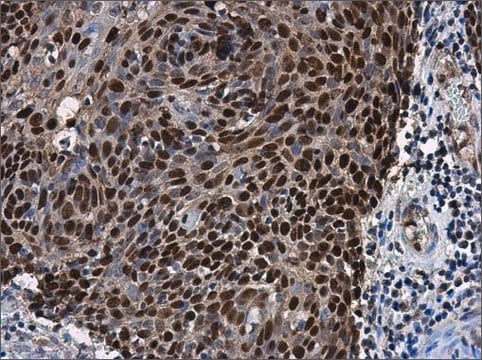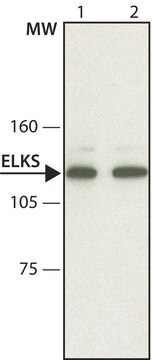MABN72
Anti-pan-MAGUK Antibody, clone K28/86
clone K28/86, from mouse
Sinônimo(s):
discs, large homolog 4 (Drosophila), discs large homolog 4, disks large homolog 4, Tax interaction protein 15, post-synaptic density protein 95, Postsynaptic density protein 95, Synapse-associated protein 90
About This Item
Produtos recomendados
fonte biológica
mouse
Nível de qualidade
forma do anticorpo
purified immunoglobulin
tipo de produto de anticorpo
primary antibodies
clone
K28/86, monoclonal
reatividade de espécies
rat
reatividade da espécie (prevista por homologia)
human (immunogen homology), mouse (based on 100% sequence homology)
técnica(s)
immunohistochemistry: suitable
immunoprecipitation (IP): suitable
western blot: suitable
Isotipo
IgG1λ
nº de adesão NCBI
nº de adesão UniProt
Condições de expedição
wet ice
modificação pós-traducional do alvo
unmodified
Informações sobre genes
human ... DLG4(1742)
Descrição geral
Especificidade
Imunogênio
Aplicação
Immunoprecipitation Analysis: A previous lot of this antibody was successfully used by an independent laboratory in IP. (Rasband, M., et al. (2002). The Journal of Cell Biology. 159(4):663–672.)
Neuroscience
Signaling Neuroscience
Qualidade
Western Blot Analysis: 0.5 µg/mL of this antibody detected members of the MAGUK protein family on 10 µg of rat brain tissue lysate.
Descrição-alvo
forma física
Armazenamento e estabilidade
Nota de análise
Rat brain tissue lysate
Outras notas
Exoneração de responsabilidade
Not finding the right product?
Try our Ferramenta de seleção de produtos.
recomendado
Código de classe de armazenamento
12 - Non Combustible Liquids
Classe de risco de água (WGK)
WGK 1
Ponto de fulgor (°F)
Not applicable
Ponto de fulgor (°C)
Not applicable
Certificados de análise (COA)
Busque Certificados de análise (COA) digitando o Número do Lote do produto. Os números de lote e remessa podem ser encontrados no rótulo de um produto após a palavra “Lot” ou “Batch”.
Já possui este produto?
Encontre a documentação dos produtos que você adquiriu recentemente na biblioteca de documentos.
Nossa equipe de cientistas tem experiência em todas as áreas de pesquisa, incluindo Life Sciences, ciência de materiais, síntese química, cromatografia, química analítica e muitas outras.
Entre em contato com a assistência técnica








